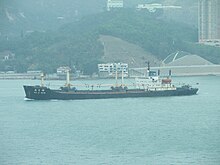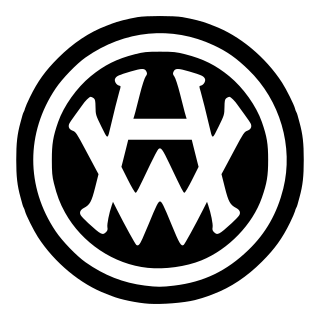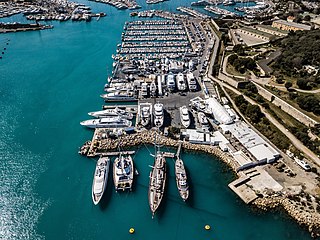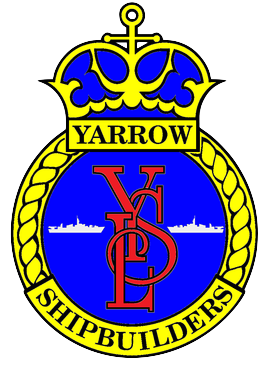 Southwick Yard, 1961 | |
| Industry | Shipbuilding |
|---|---|
| Founded | 1954 (as Austin & Pickersgill) |
| Headquarters | |
Austin & Pickersgill is a shipbuilding company formed in Sunderland in 1954.
 Southwick Yard, 1961 | |
| Industry | Shipbuilding |
|---|---|
| Founded | 1954 (as Austin & Pickersgill) |
| Headquarters | |
Austin & Pickersgill is a shipbuilding company formed in Sunderland in 1954.

Austin & Pickersgill was formed in Sunderland in 1954 by the merger of S.P. Austin & Son Ltd (founded by Samuel Peter Austin in c.1826) and William Pickersgill & Sons Ltd (founded c. 1838). [1] [2] After the merger, Austin's Wear Dock yard was used for repair while shipbuilding was concentrated at Pickersgill's Southwick Yard. The latter was modernised with the introduction of large assembly shops and prefabrication processes. [1] This reduced costs and increased the maximum size of a vessel that the yard could build from 10,000 to 40,000 tons deadweight.
In 1957 a consortium of three companies led by London & Overseas Freighters Ltd. (LOF) took over Austin & Pickersgill. [3] In October 1968 Austin & Pickersgill took over Bartram & Sons Ltd, whose South Dock yard was also in Sunderland. [1] In 1970 London and Overseas Freighters bought out the other members of the consortium to take 100% ownership of Austin & Pickersgill.
In 1977 Austin & Pickersgill was nationalised as a member company of British Shipbuilders. [4] In 1986 the company was merged with Sunderland Shipbuilders Ltd to form North East Shipbuilders Ltd. [5] However, both the Southwick and the Doxford Pallion Shipbuilding Yards closed in 1988 following negotiations with the European Commission to reduce shipbuilding capacity in the UK. [6]

A&P maximised the competitiveness of its prefabrication process by producing ships to standard designs rather than individual specifications. From 1962 onwards the company offered standard bulk carriers in a range of sizes designated according to tonnage. A&P's most numerous product was another of its standard designs, the SD14 shelter deck cargo ship. During the Second World War, shipyards in the United States had delivered more than 2,700 Liberty ship shelter deck cargo ships. [7] By the 1960s many Liberty ships were reaching the end of their service lives, so in 1965 A&P started to develop a low-cost shelter-deck cargo vessel to replace them. [7]
A&P invited other UK shipbuilders to tender for licences to produce SD14s, but by 1966 only Bartram's could meet A&P's requirement to build each ship to a selling price of £915,000. Both Bartram's and A&P built their first SD14s in 1967 [1] and handed them to their new owners in February 1968. A&P's takeover of Bartram's followed in October. [1]
In 1967 A&P licensed Hellenic Shipyards Co. of Skaramangas in Greece to build twenty SD14s. In 1971 A&P licensed Companhia Comércio e Navegação to build SD14s at Mauá in Brazil.

In 1973 Robb Caledon Shipbuilding of Dundee in Scotland contracted to build three SD14s. Astilleros y Fábricas Navales del Estado also obtained permission to build six SD14s in its yard at Ensenada in Argentina.
By the time production ceased, 211 SD14s had been built either at A&P's Southwick and South Dock yards and or by licensees in Greece, Brazil, Scotland and Argentina. [7] The largest volume of sales was to Greek shipowners. [7] The SD14 and B-series standard ship designs, and the prefabrication methods by which they were built enabled A&P to maintain a full order book until nationalisation in 1977, in contrast to many other UK shipbuilders in that era. [8]

Harland & Wolff is a British shipbuilding company based in Belfast, Northern Ireland. It specialises in ship repair, shipbuilding and offshore construction. Harland & Wolff is famous for having built the majority of the ocean liners for the White Star Line, including Olympic-class trio – RMS Olympic, RMS Titanic and HMHS Britannic. Outside of White Star Line, other ships that have been built include the Royal Navy's HMS Belfast; Royal Mail Line's Andes; Shaw, Savill & Albion's Southern Cross; Union-Castle's RMS Pendennis Castle; and P&O's Canberra. Harland and Wolff's official history, Shipbuilders to the World, was published in 1986.

A shipyard, also called a dockyard or boatyard, is a place where ships are built and repaired. These can be yachts, military vessels, cruise liners or other cargo or passenger ships. Dockyards are sometimes more associated with maintenance and basing activities than shipyards, which are sometimes associated more with initial construction. The terms are routinely used interchangeably, in part because the evolution of dockyards and shipyards has often caused them to change or merge roles.

Cammell Laird is a British shipbuilding company. It was formed from the merger of Laird Brothers of Birkenhead and Johnson Cammell & Co of Sheffield at the turn of the twentieth century. The company also built railway rolling stock until 1929, when that side of the business was separated and became part of the Metropolitan-Cammell Carriage & Wagon Company.
British Shipbuilders (BS) was a public corporation that owned and managed the shipbuilding industry in Great Britain from 1977 through the 1980s. Its head office was at Benton House in Newcastle upon Tyne, England.

The Aircraft and Shipbuilding Industries Act 1977 is an Act of the Parliament of the United Kingdom that nationalised large parts of the UK aerospace and shipbuilding industries and established two corporations, British Aerospace and British Shipbuilders (s.1).

Yarrow Shipbuilders Limited (YSL), often styled as simply Yarrows, was a major shipbuilding firm based in the Scotstoun district of Glasgow on the River Clyde. It is now part of BAE Systems Surface Ships, owned by BAE Systems, which has also operated the nearby Govan shipyard since 1999.

Mazagon Dock Shipbuilders Limited (MDL), formerly called Mazagon Dock Limited, is a shipyard situated in Mazagaon, Mumbai. It manufactures warships and submarines for the Indian Navy and offshore platforms and associated support vessels for offshore oil drilling. It also builds tankers, cargo bulk carriers, passenger ships and ferries.

William Doxford & Sons Ltd, often referred to simply as Doxford, was a British shipbuilding and marine engineering company.
Southwick is a former village and now a suburb on the north banks of the River Wear in the city of Sunderland in the county of Tyne and Wear, historically in County Durham. From 1894 to 1928, Southwick was administered by the Southwick-on-Wear Urban District Council, before being absorbed by Sunderland.

Burrard Dry Dock Ltd. was a Canadian shipbuilding company headquartered in North Vancouver, British Columbia. Together with the neighbouring North Van Ship Repair yard and the Yarrows Ltd. yard in Esquimalt, which were eventually absorbed, Burrard built over 450 ships, including many warships built and refitted for the Royal Navy and Royal Canadian Navy in the First and Second World Wars.

Hall, Russell & Company, Limited was a shipbuilder based in Aberdeen, Scotland.

Bartram & Sons was a shipbuilder on Wearside, North East England, that specialised in building cargo ships. It was founded in 1837, taken over in 1968, nationalised in 1977 and closed in 1978.

A&P Group Ltd is the largest ship repair and conversion company in the UK, with three shipyards located in Hebburn, Middlesbrough and Falmouth. The company undertakes a wide variety of maintenance and repair work on commercial and military ships with projects ranging from a two-day alongside repair period through to multimillion UK pound conversion projects lasting for a year or more.
Clelands Shipbuilding Company was a leading British shipbuilding company. The Company was based in Wallsend was nationalised by the British Government. It was founded in 1864 by John and Thomas Cleland, and operated until it was acquired by Swan Hunter & Wigham Richardson in 1967. The company built a variety of ships, including passenger ships, cargo ships, and naval vessels.

William Pile was a British shipbuilder. 'His genius was displayed in the building of ships, wherein he was not excelled. As Watt was great as a builder of engines; and Stephenson was great as a builder of railways; so William Pile was great as a builder of ships.'

London & Overseas Freighters Ltd. (LOF) was an ocean-going merchant shipping company that for most of its history was based in the United Kingdom.

In 685, King Ecgfrith granted Benedict Biscop a "sunder-land". Also in 685 The Venerable Bede moved to the newly founded Jarrow monastery. He had started his monastic career at Monkwearmouth monastery and later wrote that he was "ácenned on sundorlande þæs ylcan mynstres". This can be taken as "sundorlande" or the settlement of Sunderland. Alternatively, it is possible that Sunderland was later named in honour of Bede's connections to the area by people familiar with this statement of his.

The MV Murree was a 1981 ship of the SD18 type, which sank in the English Channel in 1989.
SD18 is the designation of a type of cargo ship, built by Austin & Pickersgill at their yard in Southwick, Sunderland, England in 1980–1981. Only three were built: Murree, Kaghan and Ayubia. The name SD18 stands for "shelter decker, 18,000 tons".